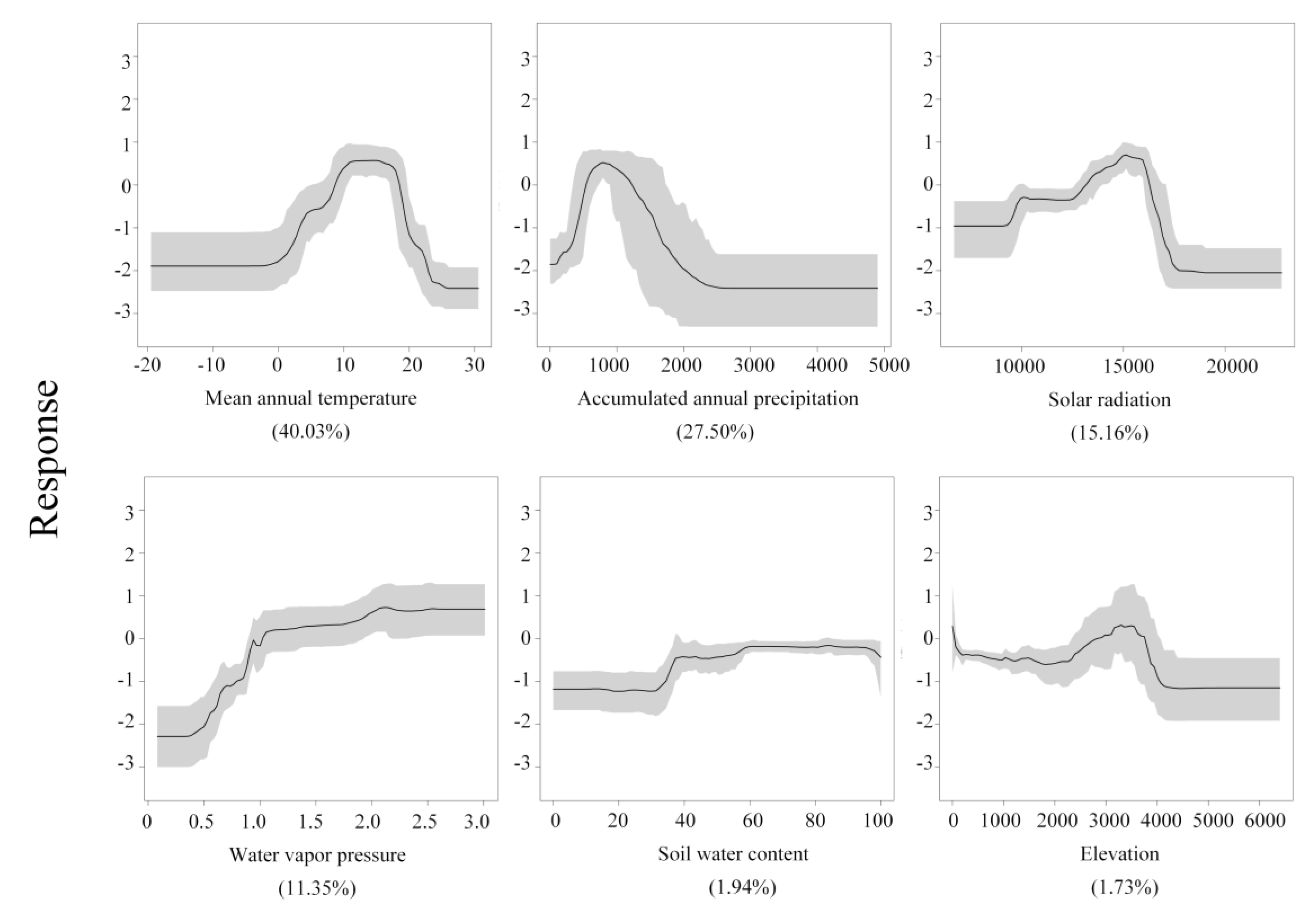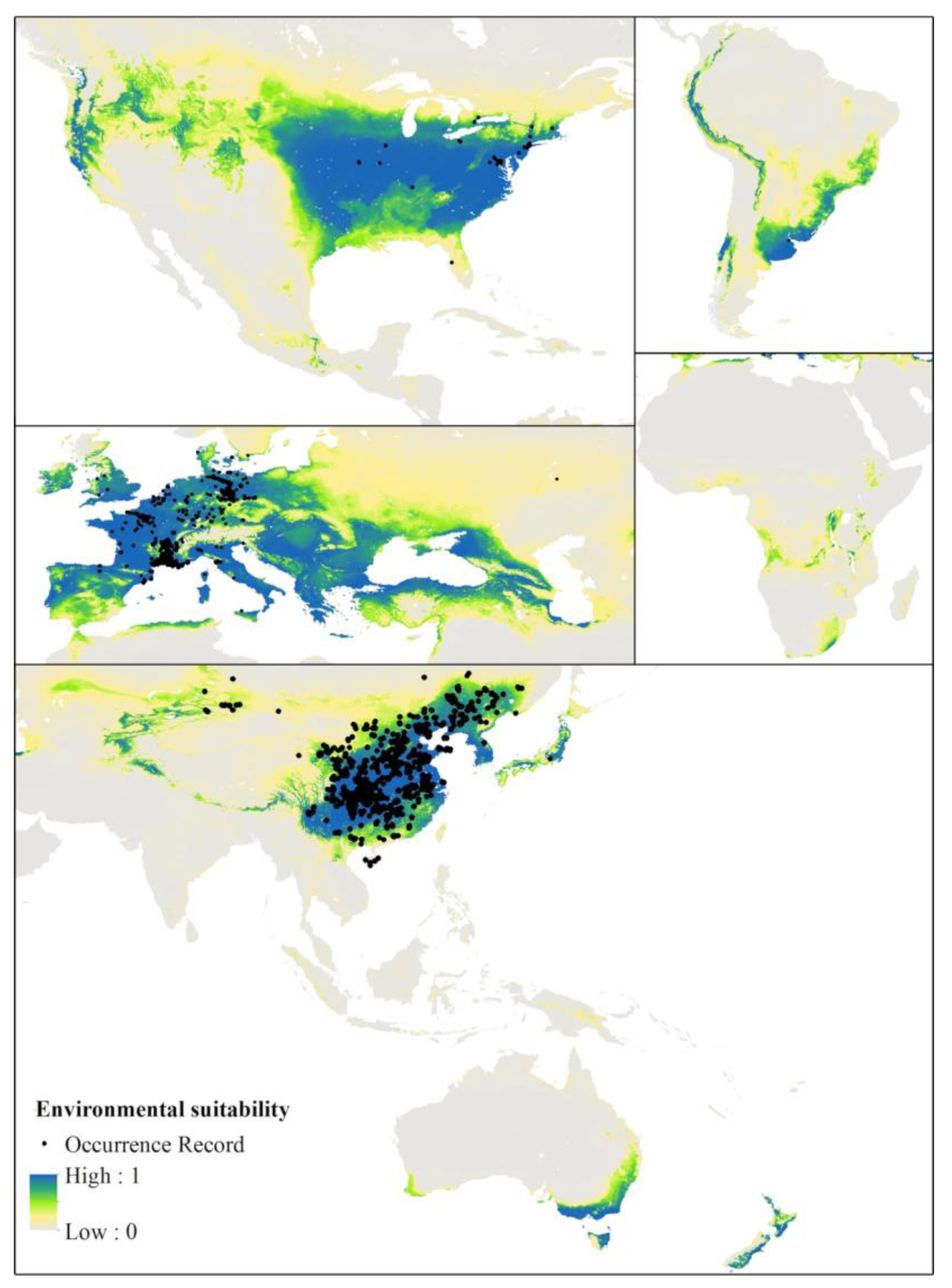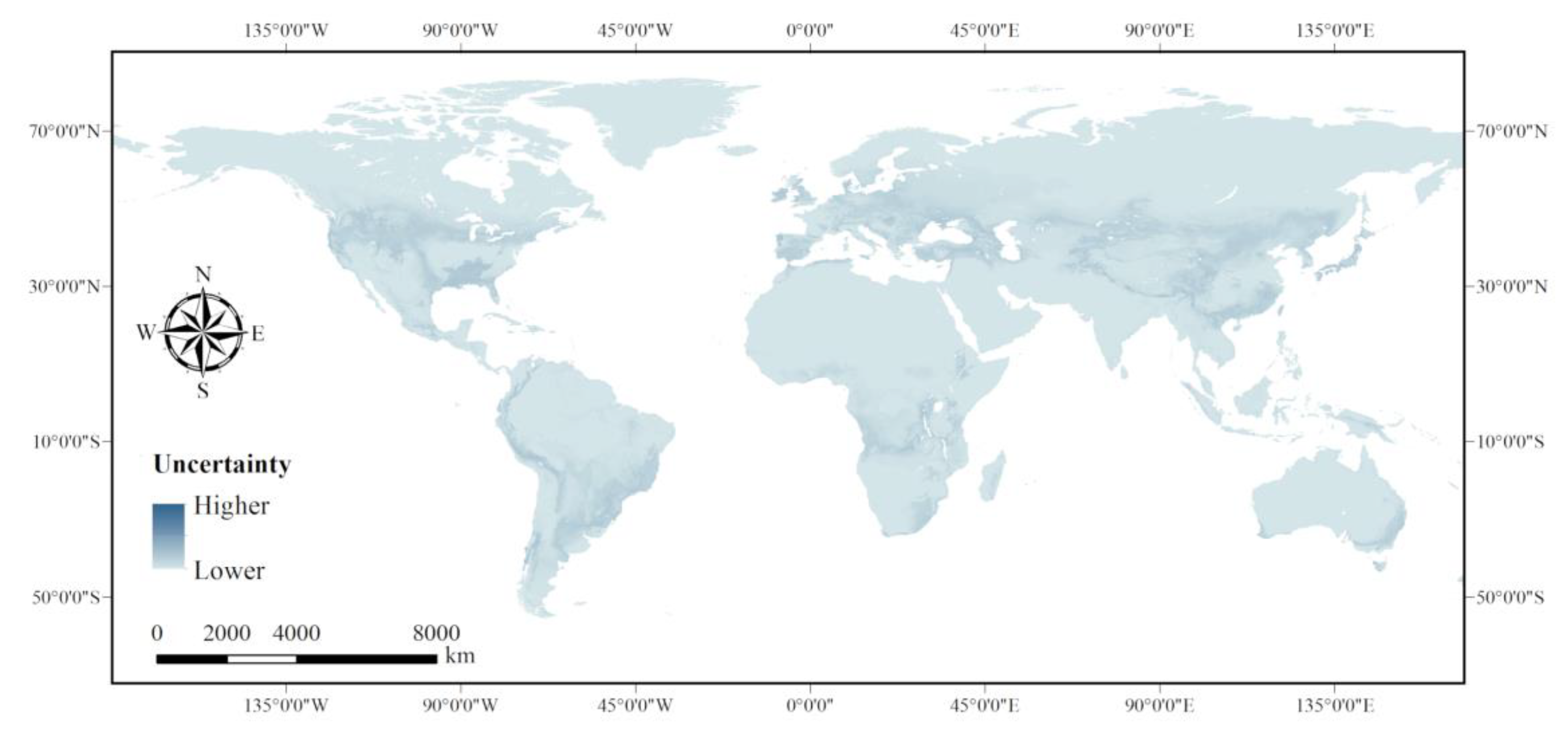Mapping Worldwide Environmental Suitability for Artemisia annua L.
Abstract
1. Introduction
2. Materials and Methods
2.1. Data
2.1.1. Spatial Predictor Covariates
2.1.2. Occurrence Records and Background Points
2.2. Modelling Analyses
3. Results
3.1. Relative Contribution of the Spatial Predictor Variables
3.2. Potential Environmental Suitability for A. annua Worldwide
3.3. Accuracy Evaluation
3.4. Potential Land Resources Suitable for A. annua
4. Discussion
5. Conclusions
Supplementary Materials
Author Contributions
Funding
Acknowledgments
Conflicts of Interest
References
- Vlassov, V. Global, regional and national incidence and death for HIV, tuberculosis and malaria during 1990–2013: A systematic analysis for the global burden of disease study 2013. Lancet 2011, 384, 1005. [Google Scholar]
- WHO. World Malaria Report 2018; World Health Organization: Geneva, Switzerland, 2018. [Google Scholar]
- Graham, I.A.; Besser, K.; Blumer, S.; Branigan, C.A.; Czechowski, T.; Elias, L.; Guterman, I.; Harvey, D.; Isaac, P.G.; Khan, A.M.; et al. The Genetic Map of Artemisia annua L. Identifies Loci Affecting Yield of the Antimalarial Drug Artemisinin. Science 2010, 327, 328–331. [Google Scholar] [CrossRef] [PubMed]
- Jeffrey, S.; Pia, M. The economic and social burden of malaria. Nature 2002, 415, 680–685. [Google Scholar]
- Koenraadt, C.J.M.; Takken, W. Integrated approach to malaria control. Science 2018, 359, 528–529. [Google Scholar] [PubMed]
- Greenwood, B. Progress with the PfSPZ Vaccine for malaria. Lancet Infect. Dis. 2017, 17, 463–464. [Google Scholar] [CrossRef]
- Klayman, D. Qinghaosu (artemisinin): An antimalarial drug from China. Science 1985, 228, 1049–1055. [Google Scholar] [CrossRef]
- Wang, J.; Xu, C.; Liao, F.L.; Jiang, T.; Krishna, S.; Tu, Y. A Temporizing Solution to Artemisinin Resistance. N. Engl. J. Med. 2019, 380, 2087–2089. [Google Scholar] [CrossRef]
- Dondorp, A.M.; Fairhurst, R.M.; Slutsker, L.; MacArthur, J.R.; Breman, J.G.; Guérin, P.J.; Wellems, T.E.; Ringwald, P.; Newman, R.D.; Plowe, C.V. The threat of artemisinin-resistant malaria. N. Engl. J. Med. 2011, 365, 1073–1075. [Google Scholar] [CrossRef]
- Luo, Z.Z.; Yang, S.Q.; Zeng, Y.M. Study on the Climate Adaptability and Division of Artemisia annua. Chongqing J. Southwest Univ. 2013, 35, 139–143. [Google Scholar]
- Huang, L.; Xie, C.; Duan, B.; Chen, S. Mapping the potential distribution of high artemisinin-yielding Artemisia annua L. (Qinghao) in China with a geographic information system. Chin. Med. 2010, 5, 18. [Google Scholar] [CrossRef]
- Zhang, Q.; Wen, J.; Guo, J.; Sun, C.; Xie, C. Production regionalization of medicinal sweet wormwood Artemisia annua. J. Plant Prot. 2018, 45, 501–503. [Google Scholar]
- Pecchi, M.; Marchi, M.; Burton, V.; Giannetti, F.; Moriondo, M.; Bernetti, I.; Bindi, M.; Chirici, G. Species distribution modelling to support forest management. A literature review. Ecol. Model. 2019, 411, 108817. [Google Scholar] [CrossRef]
- Jiang, N.; Ma, T.; Ding, F.; Fu, J.; Hao, M.; Wang, Q.; Chen, S. Mapping Global Environmental Suitability for Sorghum bicolor (L.) Moench. Energies 2019, 12, 1928. [Google Scholar] [CrossRef]
- Jiang, N.; Wang, Q.; Ding, F.; Fu, J.; Hao, M. Potential marginal land resources of cassava worldwide: A data-driven analysis. Renew. Sustain. Energy Rev. 2019, 104, 167–173. [Google Scholar] [CrossRef]
- Herrmann, S.; Jessing, K.K.; Jørgensen, N.O.; Cedergreen, N.; Kandeler, E.; Strobel, B.W. Distribution and ecological impact of artemisinin derived from Artemisia annua L. in an agricultural ecosystem. Soil Boil. Biochem. 2013, 57, 164–172. [Google Scholar] [CrossRef]
- Ferreira, J.F.; Laughlin, J.C.; Delabays, N.; De Magalhães, P. Cultivation and genetics of Artemisia annua L. for increased production of the antimalarial artemisinin. Plant Genet. Resour. 2005, 3, 206–229. [Google Scholar] [CrossRef]
- Aftab, T.; Ferreira, J.F.S.; Khan, M.M.; Naeem, M. Artemisia annua—Pharmacology and Biotechnology; Aftab, T., Ferreira, J.F.S., Khan, M.M., Naeem, M., Eds.; Springer: Heidelberg, Germany, 2014. [Google Scholar]
- Thu, B.T.T.; Van Minh, T.; Lim, B.P.; Keng, C.L. Effects of Environmental Factors on Growth and Artemisinin Content of Artemisia annua L. Trop. Life Sci. Res. 2011, 22, 37–43. [Google Scholar]
- WHO. Artemisia annua Plantation and Harvest Quality Management Practices; WHO: Geneva, Switzerland, 2007. [Google Scholar]
- Jiang, D.; Hao, M.; Fu, J.; Zhuang, D.; Huang, Y. Spatial-temporal variation of marginal land suitable for energy plants from 1990 to 2010 in china. Sci. Rep. 2014, 4, 5816. [Google Scholar] [CrossRef]
- Zheng, C.; Jiang, N.; Ding, F.; Fu, J.; Hao, M. Spatiotemporal Patterns and Risk Factors for Scrub Typhus from 2007 to 2017 in Southern China. Clin. Infect. Dis. 2018, 69, 1205–1211. [Google Scholar] [CrossRef]
- Messina, J.P.; Kraemer, M.U.; Brady, O.J.; Pigott, D.M.; Shearer, F.M.; Weiss, D.J.; Golding, N.; Ruktanonchai, C.W.; Gething, P.W.; Cohn, E.; et al. Mapping global environmental suitability for Zika virus. eLife 2016, 5, 15272. [Google Scholar] [CrossRef]
- Chen, I.; Cooney, R.A.; Feachem, R.G.; Lal, A.; Mpanju-Shumbusho, W. The Lancet Commission on malaria eradication. Lancet 2018, 391, 1556–1558. [Google Scholar] [CrossRef]
- Wang, H.; Li, H.; Zeng, F.-L.; Xie, C.-X. Spatial Distribution and Global Potential Suitability Regions of Artemisia annua. J. Chin. Med. Mater. 2015, 38, 460. [Google Scholar]
- Chen, S.; Xiang, L.; Li, L.; Wu, L.; Huang, L.; Zhang, N.; Sun, P. Global strategy and raw material production on artemisinin resources regeneration. Chin. Sci. Bull. 2017, 62, 1982–1996. [Google Scholar] [CrossRef]
- Hay, S.I.; Guerra, C.A.; Tatem, A.J.; Noor, A.M.; Snow, R.W. The global distribution and population at risk of malaria: Past, present, and future. Lancet Infect. Dis. 2004, 4, 327–336. [Google Scholar] [CrossRef]



| Category | Predictor Variables | Data Source |
|---|---|---|
| Meteorology | Annual cumulative precipitation (mm) | WorldClim database, version 2.0 |
| Mean annual temperature (°C) | ||
| Mean annual water vapor pressure (kPa) | ||
| Solar radiation | Mean solar radiation (kJ m−2 day−1) | WorldClim database, version 2.0 |
| Soil | Soil water content (%) | World Soil Information |
| Soil class | ||
| Soil depth (mm) | ||
| Topography | Elevation (m) | CGIAR Consortium for Spatial Information |
| Slope (°) |
| Mean Relative Importance (%) | Standard Deviation (%) | |
|---|---|---|
| Meteorological factors † | 78.88 | — |
| Mean annual temperature | 40.03 | 3.98 |
| Accumulated annual precipitation | 27.50 | 4.86 |
| Mean annual water vapor pressure | 11.35 | 4.55 |
| Solar radiation factor † | 15.16 | — |
| Mean solar radiation | 15.16 | 1.80 |
| Soil factors † | 3.04 | — |
| Soil water content | 1.94 | 0.96 |
| Soil class | 0.72 | 0.59 |
| Soil depth | 0.38 | 0.20 |
| Topographical factors † | 2.92 | — |
| Elevation | 1.73 | 0.37 |
| Slope | 1.19 | 0.30 |
| Region/Country | Estimated Potential Area (million hectares) |
|---|---|
| Asia | 516.50 |
| China | 391.49 |
| Turkey | 36.36 |
| North America | 354.56 |
| United States | 349.60 |
| Europe | 378.82 |
| France | 60.25 |
| Spain | 39.10 |
| Germany | 36.49 |
| Italy | 28.71 |
| South America | 172.01 |
| Argentina | 61.10 |
| Brazil | 52.65 |
| Oceania | 49.17 |
| Australia | 34.92 |
| Africa | 25.50 |
| World | 1496.56 |
© 2020 by the authors. Licensee MDPI, Basel, Switzerland. This article is an open access article distributed under the terms and conditions of the Creative Commons Attribution (CC BY) license (http://creativecommons.org/licenses/by/4.0/).
Share and Cite
Ding, F.; Ma, T.; Hao, M.; Wang, Q.; Chen, S.; Wang, D.; Huang, L.; Zhang, X.; Jiang, D. Mapping Worldwide Environmental Suitability for Artemisia annua L. Sustainability 2020, 12, 1309. https://doi.org/10.3390/su12041309
Ding F, Ma T, Hao M, Wang Q, Chen S, Wang D, Huang L, Zhang X, Jiang D. Mapping Worldwide Environmental Suitability for Artemisia annua L. Sustainability. 2020; 12(4):1309. https://doi.org/10.3390/su12041309
Chicago/Turabian StyleDing, Fangyu, Tian Ma, Mengmeng Hao, Qian Wang, Shuai Chen, Di Wang, Luqi Huang, Xiaobo Zhang, and Dong Jiang. 2020. "Mapping Worldwide Environmental Suitability for Artemisia annua L." Sustainability 12, no. 4: 1309. https://doi.org/10.3390/su12041309
APA StyleDing, F., Ma, T., Hao, M., Wang, Q., Chen, S., Wang, D., Huang, L., Zhang, X., & Jiang, D. (2020). Mapping Worldwide Environmental Suitability for Artemisia annua L. Sustainability, 12(4), 1309. https://doi.org/10.3390/su12041309






